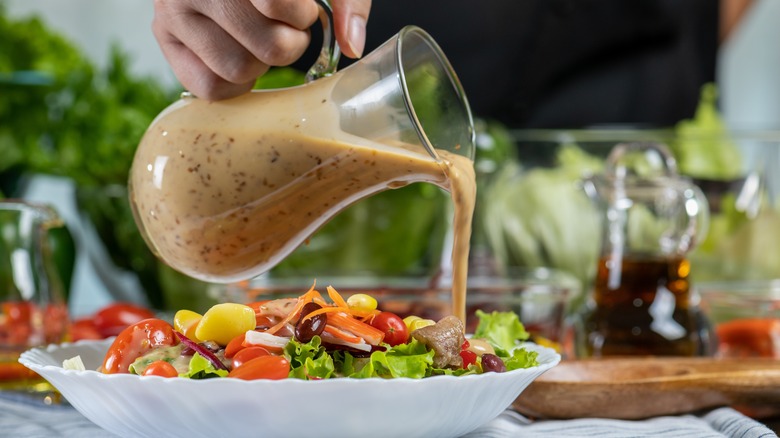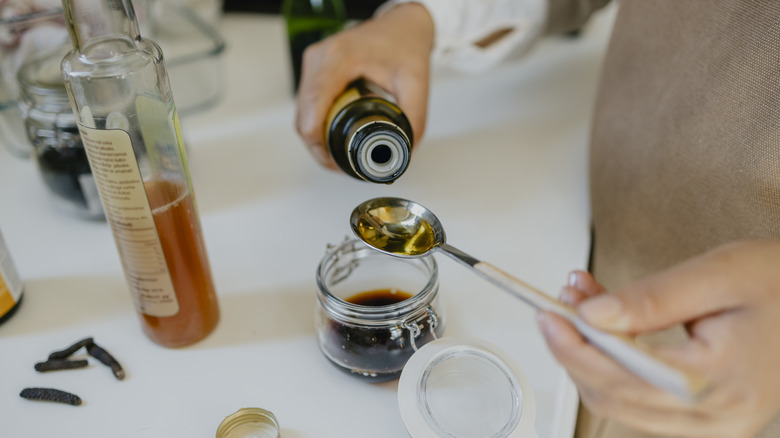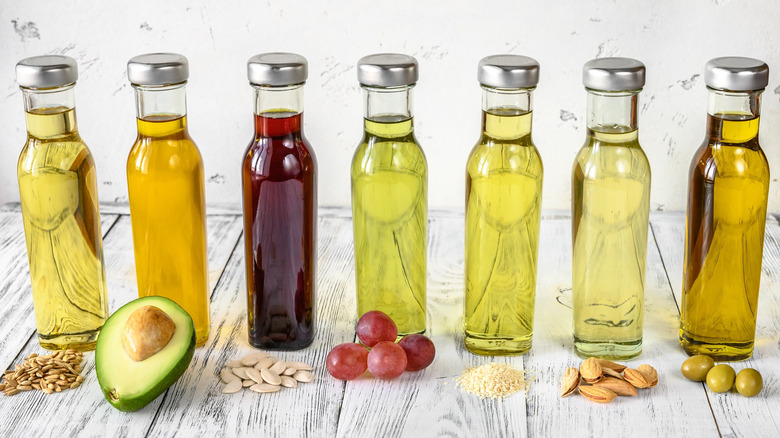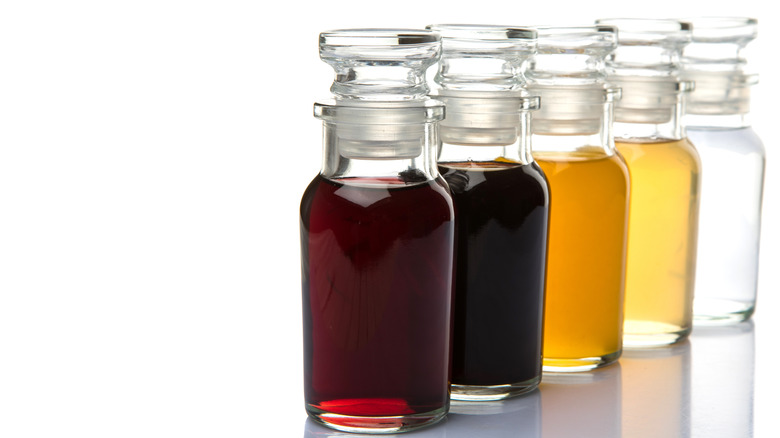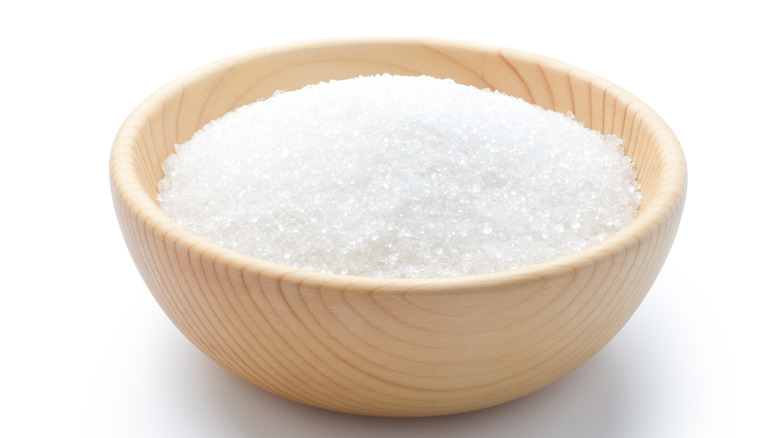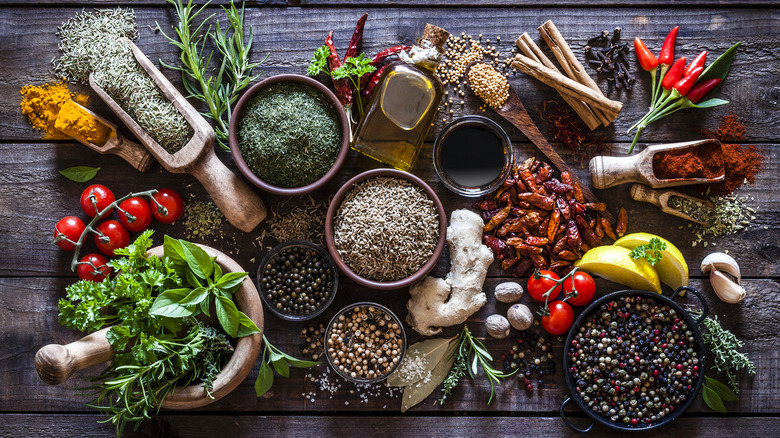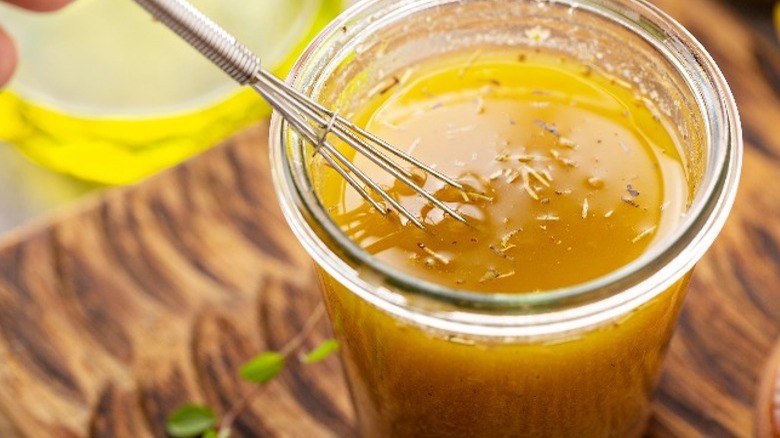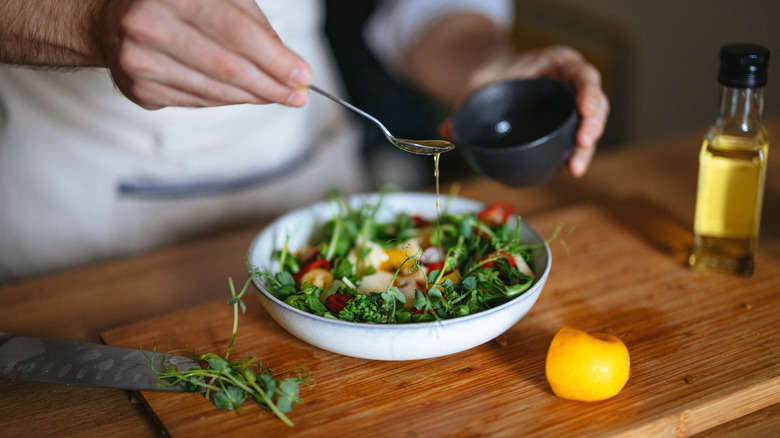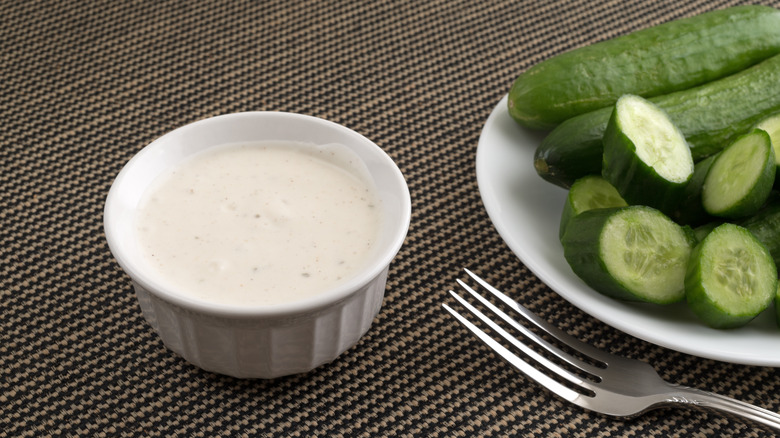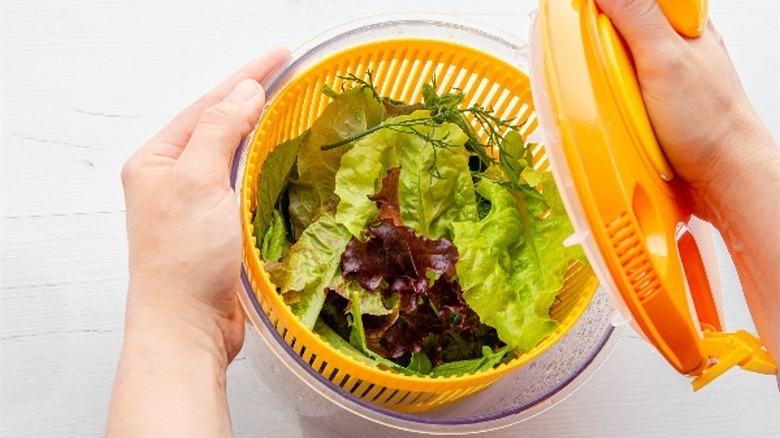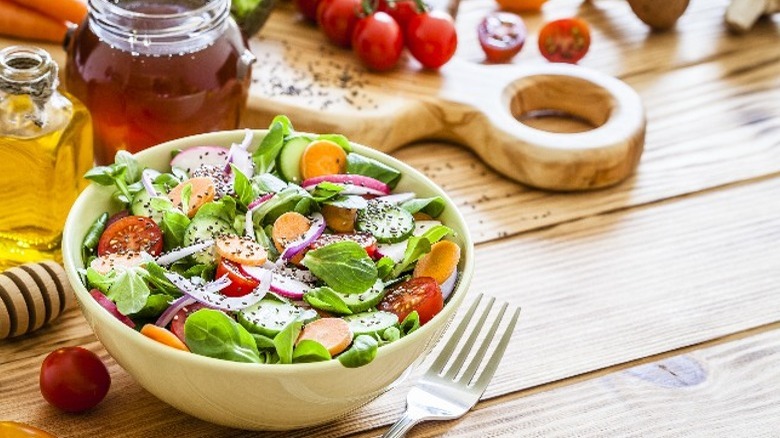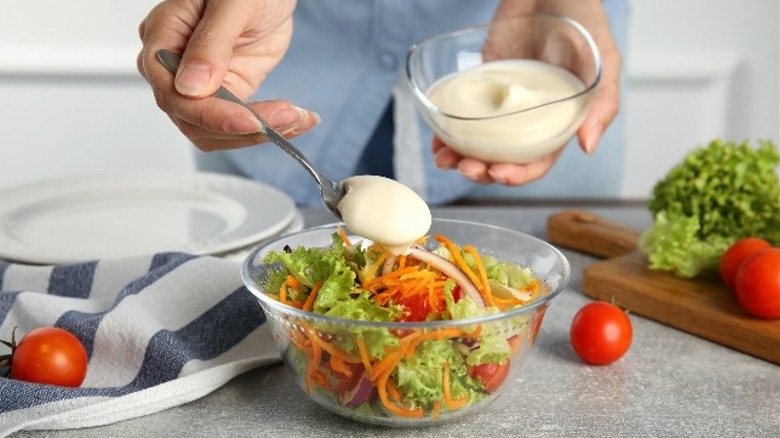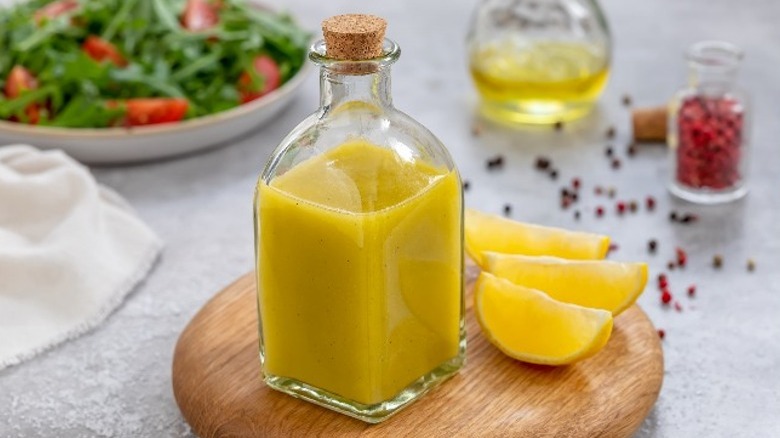14 Homemade Salad Dressing Mistakes You're Making
When you make your own salad dressing instead of purchasing it at the grocery store, you are in control of the ingredients you use. Store-bought dressings often have a long list of ingredients, many of which can be artificial or considered unhealthy. In addition to being potentially more nutritious, making your own salad dressing can also help reduce food waste because you can make smaller quantities that will get used before it spoils.
However, before you start mixing ingredients together, there are several salad dressing mistakes that you'll want to learn about. Taking steps to make sure that you avoid these errors will help ensure your finished product is healthy, delicious, and the perfect complement to your salad. Don't waste your time and effort making a dressing that isn't going to taste as expected or desired.
1. Not adding the right ratio of oil and vinegar
Vinaigrettes require just two basic ingredients: oil and vinegar. However, you can't just mix them together willy-nilly and hope that the dressing will turn out well. It is important to make sure that you follow the correct ratio of these two crucial ingredients. If you use too much vinegar, it is going to make your dressing very acidic. This will obviously have a negative impact on how the dressing — and thus, the entire salad — tastes.
The ideal ratio for a classic vinaigrette is three parts oil to one part vinegar. Depending on your taste preferences, you can modify this a little. For example, changing the ratio to two parts oil to one part acid will give it a little bit more of a bite, while adding four parts oil and just one part acid will yield a milder dressing.
2. Not using the right type of oil
One mistake that many people make when preparing a homemade salad dressing is choosing the wrong type of oil. While you could technically use just about any type, some are going to be a much better choice than others, especially if you're looking to add a specific flavor to your finished meal.
Olive oil is one of the varieties that people tend to reach for, but it can overpower the other ingredients you use. Sunflower oil and corn oil are two more neutral options. They can be a good option for recipes with different ingredients or seasonings that you want to make sure you're able to taste. Nut oils — such as peanut oil, walnut oil, and hazelnut oil — can also be used if you enjoy their nuttier flavors. They can add a unique spin to a standard salad. Sesame oil is a great option if you're making an Asian salad.
3. Not choosing the right type of vinegar
Once you have selected the best type of oil, don't consider yourself out of the woods quite yet. You still have a very important decision to make regarding what type of vinegar you will use. There are many different varieties of vinegar, and each will give the finished dressing a different taste.
One of the best types to use when making salad dressing is balsamic vinegar, which tastes a little sweet. It is also a little thicker than some other types of vinegar, allowing it to cling nicely to your salad. Alternatively, you could also try white vinegar if you like the acidic kick it adds to a salad. If you prefer something else that is less acidic and offers a hint of sweetness, consider using apple cider vinegar.
4. Adding too much sugar
Adding a little sugar to your dressing can help balance out the acidic taste and make it more enjoyable. However, if you add too much, it can taste overly sweet. Moreover, part of the appeal of making your own dressing is being able to make something that is healthier than what you'll find at the grocery stores. If you add too much sugar, the dressing clearly isn't going to be as healthy for you.
To avoid making the mistake of adding too much, add only a little at a time — about ¼ teaspoon or slightly more if you're making a big batch. After each addition, taste the salad dressing to determine whether it actually needs any more sugar or not. Instead of adding sugar to sweeten the dressing, you could also use honey, fruit juice, or coconut sugar. But the same rule applies when adding these sweeteners: Start with just a little at a time and taste the dressing before adding any more.
5. Not adding any seasonings
While you could technically combine only oil and vinegar and use the resulting mixture as a salad dressing, you're missing out on a ton of flavor if you don't add additional ingredients. First, start by adding a little bit of salt, along with some fresh or dried herbs, such as oregano, basil, dill, rosemary, and parsley. Alternatively, you could mix in a little minced garlic, chives, onion, or other aromatics.
A few other ways to up the flavor profile include adding a little nut butter, yogurt, parmesan cheese, fruit juice, crushed blackberries or raspberries, honey, or molasses. Adding spices, such as paprika or cumin, is another option.
6. Not emulsifying the dressing
There is one big complaint that many have about salad dressings made with oil and vinegar: They separate. This leaves them with some bites of the salad that only have oil and others that only have vinegar on them. Think back to science class. There, you likely learned that water and oil do not mix. If they are let to sit, they will separate from one another.
Fortunately, you use an emulsifier to help prevent separation. In doing so, the molecules from both the oil and vinegar bind them to one another. This reaction will result in a vinaigrette that doesn't separate, and the finished dressing will have a creamier texture. A few common emulsifiers include Dijon mustard, honey, mayonnaise, or tomato paste.
7. Always following the same recipe
If we constantly eat the same things over and over, we're going to tire of them very quickly. Always following the same salad dressing recipe — even if you really like the recipe — is going to be overkill. Before too long, your taste buds are going to be looking for something new. However, if you experiment with different recipes your taste buds aren't going to get bored. There will be something new and exciting to try, which can help you continue to make healthier choices by making your own salad dressing at home.
Fortunately, there are plenty of salad dressing options out there for you to experiment with. A few of the many options you might want to try include a French vinaigrette, honey lime vinaigrette, Greek vinaigrette, or a miso tahini dressing.
8. Not choosing the right type of dressing for your greens
Certain dressings work better with certain greens. Some greens are more delicate and will get smooshed together if you use a heavy or creamy dressing. They'll do best with a vinaigrette that is not so heavy. Other greens are much tougher and can easily handle the weight of a creamier option.
There's one more factor to consider before deciding on the right vinaigrette: the flavor profile. For example, because arugula has a stronger flavor, it pairs nicely with a sweet vinaigrette. Spring mix, on the other hand, may taste better with a tangier dressing.
Iceberg, kale, and romaine are among the crunchier and tougher types of greens you might find. Kale has a stronger flavor and can be tough, so start by giving it a massage before making the salad. Then, serve it with a citrus vinaigrette to help further break down the leaves — their acids will help to do this. Conversely, iceberg lettuce does not have much flavor of its own. It's best serviced with a creamier dressing that will add flavor.
9. Not tasting the salad dressing before using it
This next mistake is an easy one to fix: Don't drizzle your dressing on a salad before tasting it. If you don't taste it, you won't be able to tell whether it is too acidic, bland, over-seasoned, or anything else — until it is too late. Additionally, don't just dip the tip of a spoon into the dressing and taste it by itself. salad dressings are designed to be served on salads.
The best way to taste your dressing is to dip a lettuce leaf or one of the other vegetables for your salad into it. This will give you a much better idea of whether you need to add any other ingredients to the dressing.
10. Adding dressing to waterlogged lettuce leaves
Whether you buy lettuce from the grocery store or a local farmers market, it's going to have some dirt and other debris on it that needs to be washed off. Not washing your lettuce is one of the biggest mistakes you can make when preparing a salad. However, there's another mistake you can also make that will have a negative impact on how your dressing tastes: not fully drying the lettuce leaves.
If the lettuce is still wet, the dressing won't stick to it as well, so it will end up falling to the bottom of the bowl. Plus, the dressing will end up getting watered down, which will have a negative impact on the way it tastes. To avoid this issue, invest in a salad spinner to remove the excess moisture from the leaves. As an added benefit, your lettuce should last longer in the fridge, too.
11. Making your salad in a bowl that is too small
When you add salad dressing to your bowl of lettuce, ensure that it is evenly distributed throughout the whole salad. The last thing you want is huge puddles of dressing in some sections of the salad while the leaves in the other parts remain bare. If you fill a small bowl up with salad and add dressing to it, you're not going to have enough space to properly toss it, so the dressing won't be evenly distributed through the salad.
Instead, try making your salad in a much larger bowl than you think you need. Leave plenty of space to toss it around and incorporate the dressing throughout. After tossing the salad, you can transfer it to a smaller bowl to serve if you prefer.
12. Putting the dressing on the salad too early
Salads can make a great lunch. It's easy to throw one together the night before so it's ready to grab to bring to work or school. While you can add nearly all of the ingredients to your bowl and leave them sitting together in the refrigerator overnight, adding the salad dressing ahead of time will be a mistake.
If you add dressing to a salad too early, the oil will seep into the lettuce leaves. If this happens, you'll end up with wilted lettuce. The longer the dressing sits on the leaves, the more wilted the leaves will become. Go ahead and prepare your salad ahead of time, but put the salad dressing in a separate container until you're ready to eat it.
13. Not using up the dressing before it goes bad
While store-bought bottles of salad dressing may be good for several months, the same is not true for homemade dressings. It is important to know the shelf life of the different types.
Homemade vinaigrettes have the longest shelf life. If they're just made with oil and vinegar, and perhaps a few other seasonings, they can last up to a few weeks. The exception to this rule is if you add any fresh garlic to your dressing. If this is the case, you should not keep it for more than a few days due to bacteria.
Creamier homemade salad dressings do not last very long. To prevent increasing your risk of food poisoning, you shouldn't store them in your refrigerator for more than about four days.
14. Only using your homemade dressing for salads
It may be commonly referred to as salad dressing, but that doesn't mean you are limited to using your homemade dressings for salads. Depending on the specific type and flavor of the you made, there are many different ways to incorporate it into other recipes. For example, you can use dressing (particularly a vinaigrette) as a marinade for chicken and other types of meat.
If you didn't leave enough time to marinate the meat or poultry in the dressing, you could also use it as a sauce to drizzle over it right before serving. Dressing can also help enhance the taste of grilled or roasted vegetables. Salad dressing can also be used as the base for different types of dips. Mix in some sour cream or yogurt with it, and you'll have the perfect dip for chips or veggies.
